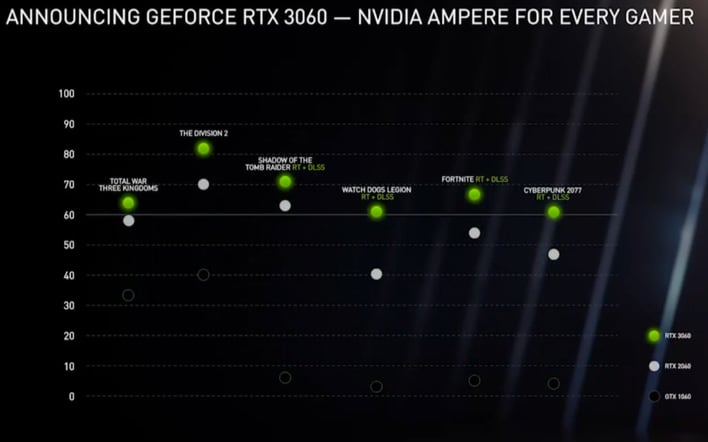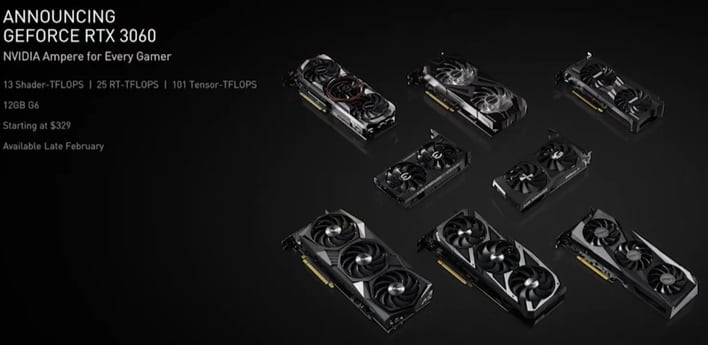NVIDIA GeForce RTX 3060 Makes A Mainstream Gaming Power Play At $329 With 12GB Of RAM

Not surprisingly, the major specs line up with what we've previously reported, and one spec is quite interesting. For starters, NVIDIA is claiming 13 shader TFLOPs performance and 12 RT-FLOPs for the GeForce RTX 3060, which is down from 16.2 TFLOPs and 31.6 RT-TFLOPS for the GeForce RTX 3060 Ti.
Where things get interesting is with the amount of memory onboard. Because of its 192-bit memory interface (versus 256-bit for the GeForce RTX 3060 Ti), the GeForce RTX 3060 has 12GB of GDDR6 instead of 8GB. In fact, the GeForce RTX 3060 has more onboard video memory than the $899 GeForce RTX 3080 (10GB) which will be a boon for value-oriented gamers, however, that latter card has faster GDDR6X.
NVIDIA sees the GeForce RTX 3060 as the perfect replacement for mainstream gamers who have long clung to the GeForce GTX 1060. According to the current Steam GPU survey, the GeForce GTX 1060 is still the most-used graphics cards for gamers using the platform (11.36 percent share as of December 2020). The next-closest GPU is the GeForce RTX 1050 Ti with a 6.46 percent share. In addition, NVIDIA says that 90 percent of current GeForce gamers are using a GTX-class GPU.
Given that the GeForce RTX 3060 is being targeted at the GeForce GTX 1060, NVIDIA is keen to point out that there is a 2x uplift in raster performance and a 10x uplift in ray-tracing performance for the new Ampere offering (although that latter figure is a bit outlandish considering that Pascal didn't have dedicated ray tracing hardware). The GeForce RTX 3060 will also be the first GeForce GPU to come out of the gate supporting NVIDIA's implementation of Resizable BAR (base address register). AMD's rolls up Resizable BAR into what it calls Smart Access Memory (SAM), which can offer a small boost in performance by allowing the CPU to secure access to the entire allotment of GPU video memory at once instead of in chunks (in supported titles).
The feature has been part of the PCIe spec since v2.0, but has only recently gained attention from GPU and motherboard manufacturers. In the case of the AMD SAM, you need a Ryzen 5000 Series CPU, an X570 motherboard and a Radeon RX 6000 Series GPU. Currently, we don't know what the system requirements are to access Resizable BAR with the GeForce RTX 3060 and other Ampere graphics cards.
When it comes to the all-important area of pricing, NVIDIA is being very aggressive here. The GeForce RTX 3060 Ti is priced at $399 (if you can actually find a Founder Edition in stock), and many were expecting the GeForce RTX 3060 to come in priced at $349. Instead, NVIDIA aimed even lower, and has priced the card at $329. Given how popular the GeForce GTX 1060 was (and still is), the GeForce RTX 3060 is bound to be an even hotter ticket for mainstream gamers, which will probably lead to shortages in the coming months.
NVIDIA says that the GeForce RTX 3060 will be available starting next month from the usual suspects like ASUS, EVGA, Gigabyte, MSI, Palit, PNY and Zotac in both stock and overclocked forms. Stay tuned for more details…



